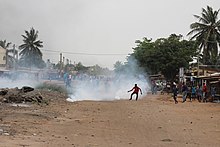

Togo
In late 2017, anti-government protests erupted in Togo, the biggest since those after the 2005 election. Protesters demanded the resignation of Gnassingbé, who is part of a family they alleged has been in power too long. The UN condemned the resulting crackdown by Togolese security forces, and Gambia’s foreign minister, Ousainou Darboe, had to issue a correction after saying that Gnassingbé should resign.
In the February 2020, presidential elections, Faure Gnassingbé won his fourth presidential term in office as the President of Togo. According to the official result, he won with a margin of around 72% of the vote share. This enabled him to defeat his closest challenger, the former prime minister Agbeyome Kodjo who had 18%. On May 4, 2020, Bitala Madjoulba, the commander of a Togolese military battalion, was found dead in his office. The day of Madjoulba’s death came right after the recently re-elected Faure Gnassingbé gave his investiture. An investigation has been opened for this case and all individuals around his death are being questioned.
Geography:
Togo has an area equal to 56,785 km2 (21,925 sq mi) and is one of the smallest countries in Africa. It borders the Bight of Benin in the south; Ghana lies to the west; Benin to the east; and to the north, Togo is bound by Burkina Faso.
The coast of Togo in the Gulf of Guinea is 56 km (35 miles) long and consists of lagoons with sandy beaches. In the north, the land is characterized by a gently rolling savanna in contrast to the center of the country, which is characterized by hills. The south of Togo is characterized by a savanna and woodland plateau which reaches a coastal plain with extensive lagoons and marshes.
The highest mountain of the country is the Mont Agou at 986 metres (3235′) above sea level. The longest river is the Mono River with a length of 400 km (250 miles). It runs from north to south.
Economy:
Togo is among the smallest countries in Africa, but possesses valuable phosphate deposits and a well-developed export sector based on agricultural products such as coffee; cocoa bean; and peanuts (groundnuts), which together generate roughly 30% of export earnings. Cotton is the most important cash crop. The fertile land occupies 11.3% of the country, most of which is developed. Major crops are cassava, jasmine rice, maize and millet. Other important sectors are brewery and the textile industry. A permanent problem is the lack of electricity, because the country is able to produce only about a third of its consumption, the rest is covered by imports from Ghana and Nigeria. Low market prices for Togo’s major export commodities, however, coupled with the volatile political situation of the 1990s and early 2000s, had a negative effect on the economy.

Togo is one of the least developed countries; the economic situation is still precarious. Togo serves as a regional commercial and trade center. The government’s decade-long efforts, supported by the World Bank and the International Monetary Fund (IMF), to carry out economic reforms, to encourage investment, and to create the balance between income and consumption has stalled. Political unrest, including private and public sector, strikes throughout 1992 and 1993, jeopardized the reform program, shrank the tax base, and disrupted vital economic activity.
